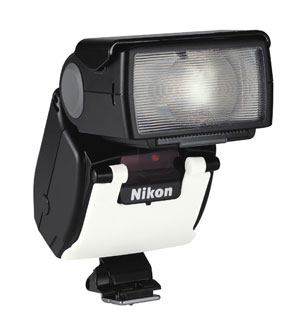| SB-50DX: Nikon's newest consumer flash | |||
After
spending a weekend with the SB-50DX I'm both entranced by some of the very
useful features that Nikon has finally added to their flash system and
disappointed that they've eliminated enough of the features needed by a
pro so that the flash is pretty much only useful for consumers. In
particular the SB-50DX is designed to work with a pop-up flash, so owners
of the N70 & N80 can add this flash and have a very powerful setup. When you first open the box, you'll be struck by the nice case and slightly smaller size of the SB-50DX. It's not enough smaller than the SB-28(DX) to buy just for the size savings, but it is a little more compact. The flash body angles forward from the camera rather than being straight up. The rotating portion of the flash head moves up and down just like with other Nikon flashes, but it is a little more difficult to orient it since the flash body is already angled. There is a wide-angle flash diffuser, although the small white "bounce card" is missing from this flash. There is another bounce card, but it is only for use as part of a dual flash setup with the pop-up flash on a Nikon consumer camera. You'll also notice that the head only moves up and down. Gone is the two dimensional pivot, so you can not use the flash to bounce light if you are shooting verticals. To begin with the overall specs, the SB-50DX has a little more than half of the Guide Number (GN) of its big brothers the SB-28 and SB-28DX. For ISO 100 at 50mm, the 28DX has a GN of 139 and the 50DX has a GN of 85. It's easy to assume that the power output is the major difference between the two. But in fact that only one of many important differences. The first two differences are apparent from reading the manual. The SB-50DX does not have an A mode, and it does not allow manual settings other than full power. For many folks this is a non-issue. But if you're one who has been wrestling with flash issues on the D1 you'll be sorely disappointed when you can't set the flash to "A." Physically examining the flash reveals a couple other important differences. Instead of the hard to use (especially in the wet and cold) ridged knob familiar from other Nikon flashes, the SB-50DX has an easy to use locking lever. That's one feature I'd like to see on the next Nikon pro flash. Unfortunately, Nikon has also removed the "detent" that keeps the flash head from depressing below horizontal. This is a real pain. Since the flash body is at an angle and there is no clear stop for the rotating section it is very easy to find yourself shooting with the flash aimed down and wondering why your flash isn't firing as far as it should. Also missing from the newer unit is the flash distance meter. So you're on your own as far as figuring out whether you have enough power to light your subject. Nikon has added the ability to set flash exposure compensation in increments of 1/6 of a stop for digital cameras. I'm not sure how much value that really is and it forces you to click the + or - button twice as often to get to a particular compensation value. One nice feature of the new flash is tighter communication with the camera. When you turn your Nikon camera off or on--if it is an N70, 80, 90, F5, F100, or D1, the flash turns itself off and on at the same time. This isn't a big deal, but it's nice that the flash and camera work together. As far as the light itself, the flash is an excellent performer in various TTL modes. The basic illumination in those modes is very similar to the SB-28(DX), except for the lower overall output. Since the camera does all the work in TTL mode it makes sense that the two flashes would perform equivalently. The only difference you'll notice here is that the SB-50DX will only zoom to 50mm. That makes it a little tougher to get the extra range you can from its big brothers when using a longer focal length lens. Nikon has also chosen to change many of the buttons and menu commands on the flash. While this may make things simpler for new users (although the length of the Instruction Book shows there is still plenty to learn!), it doesn't help anyone hoping to use this as a backup flash. Fortunately the Mode button and the +/- buttons still work the same way. The wireless slave operation of the SB-26 has also been added back to this flash, along with a special "pre-flash defeat" setting to allow the use of multiple flashes with the D1 family of camera. Unfortunately, since the SB-50DX has no "A" mode, the only way to use it as part of a multiple flash setup with a D1 is to make it the slave and set the SB-28DX master flash to "A" mode. While convenient, that's no real advantage over using either an SB-26 or an SB-28 with SU-4 as the slave unit. Another somewhat odd feature for a primarily consumer flash unit is IR remote flash triggering. With the use of the included IR filter, the SB-50DX can be used to trigger a remote flash without sending out any illumination of its own. As a wildlife photographer I'm intrigued that this might allow some creative lighting solutions for small animals in low light conditions, but I don't see this feature getting used too often by most owners. Some of the other esoteric flash modes are also missing, such as Repeating Flash. For advanced features such as rear-curtain sync, the SB-50DX relies on the camera body--again showing it is built to be used with modern Nikon bodies. Overall, if you use an N-series, F5, or F100 Nikon body, the SB-50DX might make an inexpensive low-power backup flash. You need to be comfortable shooting in TTL mode and be willing to live without features such as vertical bounce flash or extensive flash zooming. If you will be using a D1X or D1H you might be able to get away with the same type of use, since Nikon has greatly improved their digital TTL flash in those cameras. You'll gain an inexpensive wireless slave that you can use with your SB-28(DX) master flash--assuming you remember to set up the master flash not to use pre-flashes (either by putting it in A mode on your digital SLR or in regular TTL or A for your film camera) and remember to set the SB-50DX to slave mode. But if you use a D1, I wouldn't recommend buying an SB-50DX. If you find yourself in one of the many situations where TTL flash doesn't work well with the D1 your only alternative will be full power Manual! The SB-50DX is available for about half of what the SB-28DX sells for, and can certainly be found for under $200 mail order. One other big "gotcha" for those looking to save money is that the SB-50DX requires 2 CR123A Lithium batteries. These are expensive and currently don't appear to have any rechargeable replacement. Have fun, and let me know your experiences with the SB-50DX. |
Even with its lower GN, the fill from the SB-50DX was enough to help save this outdoor photo in tough mottled light conditions! |
||



